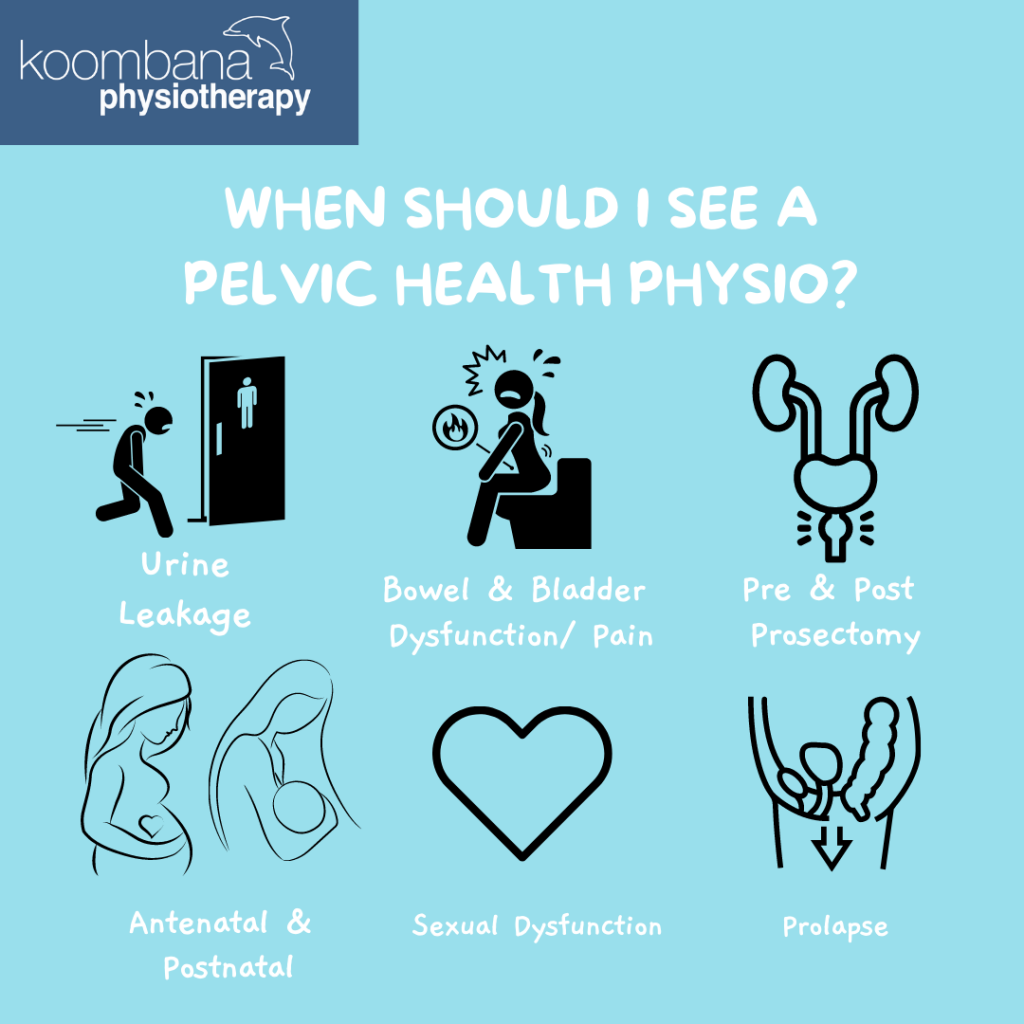 What does a Pelvic Health Physio do?
What does a Pelvic Health Physio do?
A Pelvic Health Physio treats the muscles in the pelvis known as the ‘pelvic floor’. This means, they treat everyone and anyone; including women, men and children.
There is so much a Pelvic Health Physio can do for your specific presentation, above and beyond just giving you ‘pelvic floor exercises’…
Here are some presentations in which a Pelvic Health Physio can assist:
Urine Leakage/ Incontinence
- Are you leaking urine when you cough, sneeze, jump or run?
- Are you constantly searching for the toilet?
- Are you waking up multiple times a night for a wee?
Urinary incontinence is defined as “The complaint of ANY involuntary leakage of urine” (International Continence Society)
The main types of urinary incontinence are…
- Stress incontinence: leaking urine on effort or exertion—this can be any activity that increases the pressure in your abdomen such as running, coughing, sneezing, lifting a weight.
- Urge urinary incontinence: leaking alongside a sudden urge/sensation to urinate. Your bladder is yelling at you “I need to go NOW”.
- Mixed Urinary Incontinence: symptoms of both stress and urge urinary incontinence.
- Overactive Bladder: refers to a cluster of symptoms—urgency (“I need to go NOW”), frequency (going to the toilet more often) and sometimes nocturia (waking from sleep to urinate). This can be with or without the leakage of urine.
Strong evidence exists for the use of pelvic floor muscle training to treat stress or mixed urinary incontinence. Bladder training techniques are extremely effective for urgency or mixed incontinence (NICE guidelines 2013).
Prolapse
- Or ‘Pelvic Organ Prolapse’ is when one or more of the pelvic organs (bladder, bowel or uterus) descend down and become symptomatic. It is a common condition, but is treatable.
- Symptoms can include; a bulging or heaviness in the pelvis and/or vagina, dribbling urine or incomplete emptying of the bladder, difficulty emptying the bowels, pain or difficulty with sexual intercourse.
- These symptoms are often worse at the end of the day, after exercise or being on your feet for a long period.
- A mild to moderate prolapse can benefit from pelvic floor muscle training, this may involve strengthening and improving muscle coordination to support the organs and structures involved.
- It’s not just pelvic floor exercises, your physio may assess surrounding muscles, posture, lifting techniques and your bladder and bowel function.
- Physiotherapy can significantly help to reduce symptoms of prolapse and prevent it worsening over time.
Sexual Dysfunction—Painful intercourse (Dyspareunia)
- Dyspareunia is a common condition where women experience pain during or after sexual intercourse. The pain may be at the entrance of the vagina or felt deeper inside.
- Understanding why the pain started is essential and can be due to multiple factors.
- Possible causes include: thrush, recurrent UTIs, bladder pain syndrome, menopause, endometriosis and/or pelvic floor muscle dysfunction. Psychological factors can also contribute to the pain experience and therefore also having input from a psychosexual therapist can significantly help.
- Pelvic floor dysfunction can play a big role in sexual pain. Commonly, the pelvic floor muscles are “overactive” or tight. Pelvic health physios use a range of techniques to reduce this “overactivity” and then retrain the muscles to coordinate correctly. These techniques include relaxation strategies, breath work, visualisation, massage and muscle retraining. Other adjuncts to the above include EMG and/or vaginal trainers (previously called dilators).
Pelvic Girdle Pain (PGP) during pregnancy
- PGP is fairly common during pregnancy, affecting approximately 30% of pregnant women. For some women this pain can persistent even after giving birth.
- The pelvic girdle is made up of three joints; the left and right sacroiliac joints and the pubic symphysis at the front. The pain can be coming from one, two or all of these joints.
- This pain can have a myriad of causes including hormone changes, pressure of the uterus plus baby or mobility of mother.
- A pelvic health physio can do so much to assist you in managing your symptoms. This includes; manual release work, strengthening exercises for muscles surrounding the pelvis, mobility and lifestyle advice.
PART 2 coming soon… stay tuned for more information specific to men’s health, tummy muscle separation after giving birth and MORE!